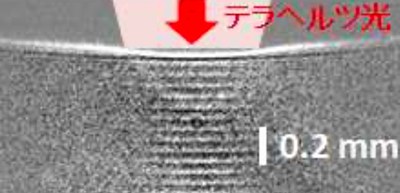
Shockwave propagation in water by THz pulsed irradiation will lead to novel THz wave-based techniques
A group of researchers from the National Institutes for Quantum Science and Technology, the RIKEN Center for Advanced Photonics, Osaka University, and SANKEN (The Institute of Scientific and Industrial Research) has discovered that terahertz (THz) pulses generate shockwaves at the surface of liquid water and that the shockwaves propagate several millimeters in depth.
Electromagnetic waves, whose frequencies fall in the range of 0.1–10 THz, are located at the boundary region between light and radio waves (wave length: 0.03~3mm). THz electromagnetic waves can provide in-depth inspection in a non-destructive manner of a wide range of materials and are used for analyzing medicines and high polymer materials because of their high permeability in materials.
In this study, the researchers irradiated THz pulsed lasers on the surface of water. A THz free electron laser (FEL) at the Institute of Scientific and Industrial Research (Osaka University) was used as the THz beam source.
As a result, they observed that the THz light was completely absorbed very close to the surface of the water, with a penetration depth of about 10 μm and that the energy of THz pulses transmitted a millimeter thick in the aqueous solution, possibly as a shockwave, without affecting the surrounding area by destructive phenomena such as plasma generation. The plane photoacoustic wave was generated by incident THz light and delivered 600 times deeper than the penetration depth of THz light for water.
Because of the high absorption of THz radiation by water, more than 99.7% of irradiated energy of THz light is absorbed within 0.1 mm of the water surface. The THz laser light with a picosecond pulse duration induced a rapid and local pressure increase followed by effective photoacoustic wave generation.
Photoacoustic waves are generated even with a relatively low light energy density (10mJ/cm2) due to effective energy transfer from THz light to photoacoustic waves. Thus, a wider laser irradiation (or the area of the photoacoustic wave source) is available. It is thought that since plane photoacoustic waves are generated as flat waves not from a point but from a large area, they propagate deeply in water.
The discovery in this study will lead to the development of invasive technology to transport energy in water only by THz light irradiation. This group was able to demolish cellular actin filaments in living cells by THz irradiation without inducing cell death.
In addition to conventional methods to generate ultrasonic waves, if a non-contact method to generate ultrasonic waves in water by THz irradiation is developed, various applications, including medical diagnosis and treatment will be available. This is expected to lead to industrial and biological applications, such as manipulating cells, DNA, and high polymer materials in water.
Figure 1
Figure 2
The article, “Propagation of THz irradiation energy through aqueous layers: Demolition of actin filaments in living cells,” was published in Scientific Reports at DOI: https://doi.org/10.1038/s41598-020-65955-5.

